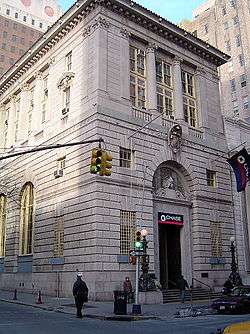Brooklyn Trust Company
|
Brooklyn Trust Company Building | |
 Brooklyn Trust Company Building, January 2007 | |
   | |
| Location |
177 Montague Street Brooklyn, New York City |
|---|---|
| Coordinates | 40°41′39.43″N 73°59′32.64″W / 40.6942861°N 73.9924000°WCoordinates: 40°41′39.43″N 73°59′32.64″W / 40.6942861°N 73.9924000°W |
| Area | 66,315 square feet[1] |
| Built | 1916 |
| Architect | York & Sawyer |
| Architectural style | Italian Renaissance |
| NRHP reference # | 09000632[2] |
| Added to NRHP | August 20, 2009 |
The Brooklyn Trust Company was a New York City bank.
History
The company was chartered in 1866.[3] In 1873 it had difficulties resulting in a brief suspension of operations.[4][5] Between 1913 and 1930 the company acquired five other banks through mergers. The company merged into the Manufacturers Trust Company on October 13, 1950.[6] At the time of the merger the Brooklyn Trust Company had 26 branches.[7]
- George Vincent McLaughlin was president of the Brooklyn Trust Company starting in 1940.
- Charles Jeremiah Mason, Jr. (1899–1990)[8] joined the Brooklyn Trust Company in 1939. He was an assistant vice-president at Brooklyn Trust Company when it merged with Manufacturers Hanover in 1950. He became an assistant vice-president at Manufacturers Hanover in 1953 and vice-president in 1955, retiring in 1964.
- William Boone Nauts (1902–1990)[9] joined the Brooklyn Trust Company in 1925. During the Depression he joined the Manufacturers Trust Company. He retired in 1967 as a vice-president of Manufacturers Hanover Trust.
Headquarters building
The former headquarters of the Brooklyn Trust Company is a historic bank building located at the corner of Montague and Clinton Streets in Brooklyn Heights. The Italian Renaissance-inspired headquarters was built between 1913 and 1916 by the architectural firm of York and Sawyer. It was modeled after the Palazzo della Gran Guardia in Verona.[10]
The building was built on the same site as the bank's previous headquarters.[3] Marc Eidlitz & Son Builders N.Y.C. constructed the building in two phases. The first half was begun at the corner of Clinton and Pierrepont Streets in late 1913 and was finished in September 1915. The second phase began in October 1915 and was completed in August 1916. The entire construction process was photographed monthly by Irving Underhill.[10]
The main interior space is inspired by ancient Roman and Italian Renaissance architecture. The banking hall has large chandeliers hanging from vaulted, coffered ceilings, arched windows, and a Cosmati-style mosaic marble floor. The building was landmarked in 1996. The interior is also landmarked.[11] It was listed on the National Register of Historic Places in 2009.[2]
The building was sold for $9.7 million in 2007 by JPMorgan Chase,[12] the successor to the Brooklyn Trust Company through the Manufacturers Trust Company.[6] It was bought by Brookfield Asset Management who in turn sold it to Stahl Real Estate Company. The building is occupied primarily by a law firm but Chase Bank still leases the ground floor to maintain a retail banking branch.[12]
Gallery
 1916
1916 Sept 1914
Sept 1914 Oct 1914
Oct 1914 Nov 1916
Nov 1916 Dec 1914
Dec 1914 Jan 1915
Jan 1915 Feb 1915
Feb 1915 Mar 1915
Mar 1915 Apr 1915
Apr 1915 May 1915
May 1915
References
- ↑ Brooklyn Daily Eagle, July 11, 2008, accessed June 27, 2011
- 1 2 "National Register of Historic Places". Weekly List Of Actions Taken On Properties: 8/17/09 Through 8/21/09. National Park Service. 2009-08-28.
- 1 2 Summary Of Statement January 1st 1907 To The State Banking Department Archived March 4, 2016, at the Wayback Machine., New-York Daily Tribune, January 1, 1907, accessed June 26, 2011
- ↑ "The Defalcation" Archived November 11, 2012, at the Wayback Machine., The New York Times, July 22, 1873, accessed June 26, 2011
- ↑ "Meeting Of The Stockholders — The Institution To Resume Business" Archived November 11, 2012, at the Wayback Machine., The New York Times, August 6, 1873, accessed June 26, 2011
- 1 2 "Archived copy". Archived from the original on 2011-09-28. Retrieved 2011-06-27.
- ↑ The History of Manufacturers Hanover Trust Company Archived June 11, 2016, at the Wayback Machine., Chase Alumni Association, accessed June 26, 2011
- ↑ Charles Jeremiah Mason, Jr. (October 26, 1899 – May 21, 1990) was born in East Orange, New Jersey. He was a son of Rev. Charles Jeremiah Mason, Sr. (September 25, 1855 – April 29, 1925) (a minister in the Episcopal Church) and Angelina Augusta Merry (June 7, 1865 – April 18, 1954), who were married on May 10, 1892. Charles J. Mason, Jr. was a graduate of Harvard University (Class of 1922). His first wife was Mary Sumner Wallace (March 29, 1905 – April 1975), whom he married on December 8, 1928 in Manhattan, New York. Mary often used the name "Polly Wallace Mason" as her married name. Charles' second wife was Katharine Hoppin (Post) Palmer (September 25, 1901 – November 26, 1998), whose first husband was Josiah Culbert Palmer, Jr. (1896–1972). An obituary for Charles J. Mason appeared in The New York Times on May 25, 1990. Charles and his first wife "Polly Wallace Mason" are buried in the Evergreen Cemetery, Stonington, New London County, Connecticut.
- ↑ William Boone Nauts (October 23, 1902 – April 5, 1990)
- 1 2 "Cultural Resource Information System (CRIS)" (Searchable database). New York State Office of Parks, Recreation and Historic Preservation. Retrieved 2016-03-01. Note: This includes Nathan Riddle; Jennifer Morris & Amy Crader (April 2009). "National Register of Historic Places Registration Form: Brooklyn Trust Company Building" (PDF). Retrieved 2016-03-01. and Accompanying 25 photographs Archived April 20, 2016, at the Wayback Machine.
- ↑ Andrew Dolkart and Matthew A. Postal, Guide to New York City Landmarks Archived January 8, 2014, at the Wayback Machine., New York: Landmarks Preservation Commission, pp. 232-233
- 1 2 Big Bank on Montague Street Archived March 4, 2016, at the Wayback Machine., brownstoner.com, accessed June 27, 2011

